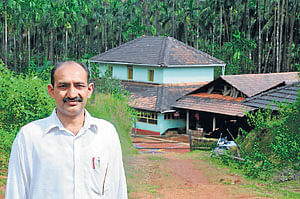Thinking beyond the grid
While most environmentalists and policy makers preach the importance of renewable energy and green practices, a primary school teacher residing in the dense forest near the Kaiga Nuclear Power Plant has actually gone a step beyond the rhetoric. He has put such mantras into practice to brighten his life.
The entire lighting requirement in his house, irrigation and domestic water pumps are all being operated on solar energy for the last 13 years. This has inspired many of his neighbours and fellow villagers to go solar. Nearly 60 per cent of the villagers now use solar energy.

Meet Narayan S Bhat of Shigekeri village situated in the forests of Kaiga, near Karwar. Like most of his neighbours, Bhat’s family has been making do without electricity, for generations now. Their only source of light, so far, were kerosene lanterns and oil lamps. However, the transformation came about in 1994, when Bhat was working as a teacher in Mundgod. “In one of the houses in Mundgod I happened to see a solar lantern in use. It was then that I decided to adopt this novel technology in my house as well,” says Bhat.
And then, there was light...
Way back in 1997, Bhat bought and installed a couple of solar panels to meet the lighting needs in his house. Over the years, he also bought direct current water and irrigation pumps and added more solar power panels. Everything from the dosa grinder and mixie in his kitchen to the TV, computer, telephone and fencing for his farm is powered by solar panels. He says that he has not experienced a single power outage in the last 10-12 years.
“We are nine of us in the family and also have many guests every day including labourers who work on the farm. A lot of cooking gets done in our kitchen and thankfully this technology has not failed us,” Bhat points out. Energy tapped from the sun is stored in batteries and used for operating lights and other appliances. When it rains though, there is no need to use the irrigation pump. The electricity that is generated is enough for our lighting and kitchen needs, he says.
School running on solar power
In fact, the government primary school adjacent to his house also uses solar power for lighting and to power the computer. Narayan Bhat, his wife Geetha and brother Ramachandra Bhat are also keen on community service.
Their house is always welcome for trekkers or naturalists who end up in the forest and have no place to stay for the night. The entire family and neighbours gather in the kitchen to cook food in case a large number of trekkers end up at their house. Bhat is popular with the students and their parents as well and has also won the Jana Mecchidanta Shikshaka Award, for his popularity. His school has also received the Uttama Shale Award. (Best School Award).
‘Stop depending on the grid’
Even though his village was finally provided electricity from the grid five years ago, he does not use it. Bhat believes solar power is the future and that the government should popularise it in a big way.
He points out that solar power should be used for small villages of about 15-20 houses which are in remote areas like a forest or in hilly areas.
Instead of cutting trees to make way for power lines, the government should set up exclusive solar power plants in such villages and hand over maintenance to the village.
He suggests that use of solar power be made compulsory for every household in the state to minimise environmental problems and also help reduce the dependence of people on the grid.
Capturing rare species on camera

K Puttaraju is unlike other officers serving at the Kaiga Nuclear Power plant near Karwar. Though he is a specialist in information science and works as a scientific officer, his passion is wildlife and conservation.
Because the nuclear power plant is situated in the dense forests of the Western Ghats, the zone around it is rich in wildlife. Puttaraju has spent several years documenting this pristine habitat on his own. He first got interested in nature when he was in the seventh standard and happened to stay on the banks of the Tunga river attending a Veda Patha Shale. “The natural beauty of the place captured my imagination and from then I started to appreciate nature more,” he says.
Among the lifeforms he has documented include the rare and threatened species such as the Malabar Giant Squirrel, Giant Pied Hornbills, tiger, flying lizards etc.
He has listed almost 300 species of butterflies and photographed many of them including the world’s tiniest grass butterfly to the largest birdwing. Puttaraju takes a deep interest in raising awareness about wildlife and its conservation. He is not only actively engaged in collecting baseline data on birds, insects and plants, but also accompanies visitors and officers into the forests to enhance their levels of appreciation.
He believes that it is important to educate young minds as they can take up larger conservation causes later. Puttaraju also visits schools and villages in and around the nuclear power plant to talk to them about conservation and training them in identifying wildlife.
He also conducts several wildlife photography exhibitions in schools. Apart from being a mountaineer, he also serves as vice-president of the Anshi Naturalist Society. Puttaraju points out that monitoring the population of wildlife on a regular basis is important to understand if there are changes in numbers and to determine causes for such a change.
Deccan Herald is on WhatsApp Channels| Join now for Breaking News & Editor's Picks